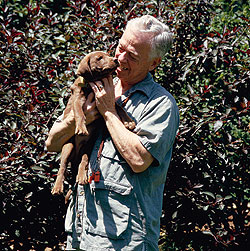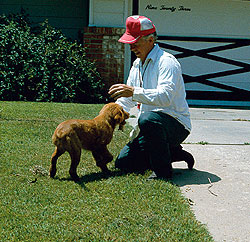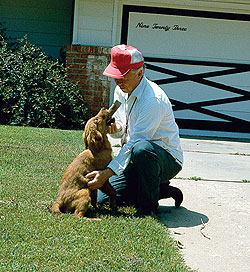Establish pup's lair, and then slowly move away from it as the number of retrieves increase.
By James B. Spencer
 Bonding must precede the first puppy retrieve. |
To succeed in awakening your puppy's "natural retrieving instinct," you must first realize that your puppy has no "natural retrieving instinct"! Don't fret; neither does anyone else's puppy. No puppy has ever had or ever will have an instinct to provide this unselfish service to mankind. Happily, however, well-bred retriever puppies do have another totally self-serving instinct, which trainers sublimate into what we euphemistically call "natural retrieving."
In the wild, carnivores instinctively consume their kills in one of two ways. The larger beasts, like lions and bears, "dine in," that is, they chow down right where the prey animal falls. Smaller animals, like canines, "carry out," that is, they tote fallen prey back to their lairs, where they can eat it safely.
Of course, domesticated dogs don't need this carrying-to-the-lair instinct, because their owners feed them regularly. Consequently, the people who developed most non-sporting breeds didn't concern themselves with preserving this instinct. However, those brilliant and benevolent souls who developed our retriever breeds cultivated it and transformed it into a "simulated retrieving instinct."
Clearly, to effect this transformation in your puppy, you must understand precisely what you're dealing with, namely, an instinct to carry prey to the lair, not an instinct to retrieve to a person. To induce your puppy to bring his "prey" to you, you must lay the proper groundwork, and then follow the proper procedure. Even if your puppy has been retrieving to the breeder, play it safe and start from scratch when you bring him home.
Groundwork
Don't try to get him to retrieve right away. Give him time to become familiar with his new surroundings, to bond with you and to establish his lair on your premises. For bonding, you should spend copious daily time with him. Play with him; teach him his name; teach him to wear a strap collar with a lead attached; take him for walks and rides in the car; in short, become his best buddy.
Being a pack animal, your puppy needs to understand his place in the pecking order. Simply put: If you don't become his pack leader, he'll become yours! The canine mind can't understand equality. To become the pack leader, you needn't be harsh with your puppy, just firm, fair and consistent.
You must establish behavioral boundaries for him, like not jumping up on you, not chewing your hands or pant cuffs, not getting on your bed and so forth. Then, you must enforce those boundaries consistently and with whatever level of gentleness or severity your puppy's individual temperament requires. "No" must always mean "No," and never anything less than "No."
While adjusting to his new home environment, your puppy will establish a lair, a place of retreat, peace and quiet. If he lives outdoors, it'll be his doghouse. If he lives indoors, it'll normally be where he sleeps. He'll carry his treasures and ill-gotten gains to his lair.
 Let your puppy continue to hold the dummy while you pet and praise him awhile. |
He'll retreat there to escape the "slings and arrows of outrageous fortune." Don't try to get him to retrieve until he has a lair and you know where it is.
His First Retrieve
With all this done, which may take a few days or a few weeks, you have everything in place to make yourself his "secondary lair," or his lair relative to "prey." You must first introduce him to a puppy-retrieving dummy, as his "prey." Put his collar and lead on him, squat down beside him and show him the dummy. Let him sniff it, hold it (but not chew on it) and carry it around as you walk him on lead. When he has no fear of it, and in fact really likes it, you and he are ready for the "big event," namely, his first actual retrieve.
Take him (on lead) to his lair. Squat down in front of it and tease him briefly with the dummy. When he's frantic to grab it, toss it a distance no longer than his lead, so you can control him with the lead on his return if necessary. Toss the dummy in a direction that puts you between him and his lair when he picks it up. He'll race after the dummy, pick it up and instinctively head for his lair. Great! When he reaches you, he'll try an end-run to get around you. Don't let him succeed.
Instead, slip your finger under his collar to stop him. He's now standing next to you, still holding the dummy, perhaps for dear life. This is the critical point. If you make a mistake here, you'll spend much unnecessary time undoing the resultant damage. Happily, the only mistake you can make is taking the dummy away from your puppy too soon.
Look at it from his perspective. He has captured his prey and tried to take it to his lair, as his instinct demands, but you have stopped him short. He knows you're the boss, but this particular prey is his, not yours. He feels that, if you want a dummy, you should go and get your own, by George!
So what should you do? Almost nothing, actually. Simply hold him in place by the collar while you pet and praise him until he relaxes his grip on the dummy. Then you can take it from his mouth without violating his sense of justice.
Again, look at it from his perspective. He captured his prey, and while trying to take it back to his lair, the nicest thing happened: His pack leader stopped him and spent so long petting and praising him that he lost interest in his prey. He will be strongly inclined to repeat that process the next time you throw the dummy.
 If your puppy starts dropping the dummy as he approaches you, don't fret. You can cure that later with force-breaking. |
And throw it again you should, as soon as he releases it willingly. Once again, stop him as he passes you and let him hold the dummy while you pet and pra
ise him until he relaxes his grip on it. Repeat this three or four times during this first session and quit while he's still anxious for more. Give him two or three well-spaced daily sessions. After a few such sessions, he'll no longer try to run around you, but will come directly to you, wanting to be petted and praised while he holds his prey. You are becoming his "secondary lair."
Moving Away From His Lair
When he no longer tries to run around you as he returns, you can begin moving away from his lair before you throw the dummy. Keep him on lead, so you can guide him to you if necessary, and make your throws short enough so you can hold the lead all the time. Continue tossing the dummy so it falls where you'll be directly between it and his lair. Also, when he reaches you, continue to pet and praise him until he relaxes his grip on the dummy.
When he returns to you reliably even when you're a considerable distance from his lair, start tossing the dummy off to each side. Keep him on lead, just in case, and keep your throws "leash-short."
When he shows no sign of wanting to take his prey to his original lair, toss it straight at that lair. Here, too, you should keep him on lead and the throw short. If he picks up the dummy, spins around and heads straight for you, rather than trying to sneak off to his original lair, you have truly become his secondary lair.
Start making longer throws in various directions. Drop the lead and let him drag it. If he hesitates to return, clap your hands and call him enthusiastically. If necessary, start running away from him, which will encourage him to chase you. At some point, in anticipation of your praise and petting, he will probably start dropping the dummy as soon as he reaches you. You can cure this later through force-breaking, so don't worry about it now. Simply pick the dummy up while you pet and praise him.
The rest is obvious. Remove the lead. Take him to different places, like parks, schoolyards and so forth. Within a few weeks, he'll be making 100-yard retrieves on coverless ground. Then you should start to steady him, but not before.
Final Suggestion
From the beginning, every time your puppy takes off after the dummy, say your command word for retrieving (probably his call name). That way, he'll come to associate that word with leaving to retrieve, an association that will greatly simplify the steadying process later on.
Jim Spencer's books can be ordered from the Gun Dog Bookshelf: Training Retrievers for Marshes & Meadows, Retriever Training Tests, Retriever Training Drills for Marking, Retriever Training Drills for Blind Retrieves, HUP! Training Flushing Spaniels the American Way, POINT! Training the All-Seasons Bird Dog, and the Gun Dog video, Duck Dog.






